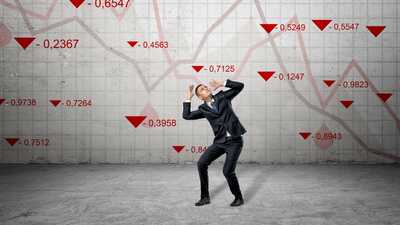| Home | About | Archives | RSS Feed |

@theMarket: Consumer Price Index Triggers Market Decline
 |
Sticky inflation, as represented by Tuesday's Consumer Price Index (CPI), caught most investors off guard. The resulting equity market rout drove the three main averages down over 4 percent. It was the worst market day in more than two years. Is the selling over?
I doubt it. The rampage lower spared few stocks. The dollar soared higher and most commodities as well as precious metals plummeted. That's what happens when you get everyone on one side of the rowboat.
Many analysts, traders, economists, and retail investors had bid up stocks in the days prior to the report in anticipation that the CPI would result in a cooler inflation print. The opposite happened and everyone headed for the exit at the same time. On Wednesday, Sept. 14, the Producer Price Index (PPI) was a bit better and came in at the consensus forecast.
It only required an hour or so before strategists were hiking their expectations for how long and how high the Fed will raise interest rates. At least one Wall Street analyst I follow raised his expectations for next week's FOMC meeting rate hike from 0.75 basis points to 100 — a full 1 percent.
I am sticking with a 0.75 basis points hike. And after this week's CPI, most of the financial community have given up on their mistaken notion that the Fed may be moving into a more dovish stance next week.
This week the Biden administration intervened to avoid a U.S. railroad strike that could have been a disaster for the economy. Aside from the backup in product shipments, the strike could have added a percentage or two to the inflation rate depending on the duration of the strike. However, the markets barely acknowledge the Biden "save."
The overall macroeconomic data still points to an economy that is chugging along, especially the labor market that still appears to be growing and with it, rising wages. That is bad news for the markets, but good news for the economy. The Fed needs to see demand start to slow and the labor market cool off before they even think of pausing in their tightening policies.
That means the stock market will continue to be pressured downward by higher interest rates and further quantitative tightening. As markets tend to do, everyone is now crowding to the other side of the rowboat. From expecting easing earlier this week, investors are suddenly convinced that the Fed's tightening is going to cause a deep recession. You can't make this stuff up!
If you are looking for proof that the Fed will over tighten and cause a disastrous decline in economic growth, look no further than Friday, Sept. 16.
Some companies are sounding warnings on the future health of U.S. and global economies. In just one day, FedEx issued a profit warning due to declining package delivery volumes around the world. International Paper said it was being hurt by decelerating orders and an inventory glut. And General Electric revealed that the company's cash flow remained under pressure as supply chain issues continued to impact their ability to deliver products.
FedEx dropped more than 20 percent on the news taking the entire transportation sector down with it, since the company is a leading indicator on the future health of economic growth.
In my opinion, the strong CPI number has stretched out the duration of the Fed's tightening regime by a quarter or two. The big money in the market believe that the Fed has lost its way and that remaining "data dependent" suggests the Fed does not know what it is doing.
I am still expecting that this next week's FOMC meeting will deliver bad news — more hawkish statements — which allow investor hysteria to expand. But maybe, just maybe, Fed Chairman Jerome Powell may try to restore some of the Fed's credibility by offering a target terminal Fed funds interest rate for this tightening regime. The historical average of the Fed funds rate is 4.25 percent, and assurances that it won't go higher could help markets recover.
As I said last week (and many weeks before that) "a retest of the year's lows in the weeks ahead," was, and still is, my call. If we break the year's lows my terminal value on the S&P 500 Index is 3,500. It doesn't have to go straight down, however. We could see bounces that could take that index up 100 points or more, and then down again.
Bill Schmick is the founding partner of Onota Partners, Inc., in the Berkshires. His forecasts and opinions are purely his own and do not necessarily represent the views of Onota Partners Inc. (OPI). None of his commentary is or should be considered investment advice. Direct your inquiries to Bill at 1-413-347-2401 or email him at bill@schmicksretiredinvestor.com.

